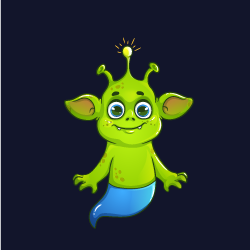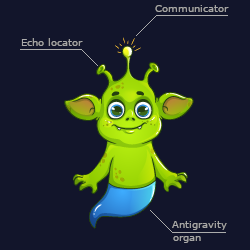


Gidallians are little, kind and very intelligent alien creatures from one of the many parallel universes that, together with our Universe, are part of the infinite Multiverse.
According to latest studies, the age of the Gidallian universe is estimated at around 25 billion years. For its creation, the Gidallians have a special word - GI, which in translation means something like the beginning of everything.
In our language we use the name Smartverse for their universe.
The first mention of the Gidallians dates back to 10 billion years after the creation of the Smartverse, which means a period of 15 billion years of their existence. Their lives began in the oceans on planets full of water, where they survived the first billion years.
When the oceans first dried up, their ability to adapt quickly to sudden changes in the environment was demonstrated. They gradually moved their lives from the oceans to the drylands, where they survived for billions of years to the present day.
Life in the depths of the oceans, however, has already remained a part of them and so far they continue to build their bases, cities and towns even under the water surface. However, they are not as monumental as the ones they build on land.
During the first years of life in the oceans, the Gidallian civilization progressed significantly in new technologies, and already in those times they managed to overcome vast intergalactic distances. As a result, new worlds and new planets were constantly being discovered suitable for living in galaxies several light-years away.
As the stars were born and died, the Gidallians moved to new homes in new galaxies.
Gidallians are sociable and have lived in colonies since the beginning. The number of individuals in one colony is about a thousand. Both males and females live in the colonies.
No hierarchy prevails here and all members of the colony are equal and each contributes to it according to their abilities and interests so that the colony can prosper.
The Mother stands in the forefront of each colony. The role of the Mother is to cluster eggs and thus mantain the population of her colony. After laying the eggs, they are kept in a strong electromagnetic fields and are gradually fertilized by a male, whom the Mother herself chooses for this purpose. The male is thus honored and becomes the Father of the family, who enjoys the same respect in the colony as the Mother.
Another important task of the Mother is to store all the knowledge and experience gained over the years in her biological memory center. The Mother's Memory Center has a huge capacity and speed of information processing. Mothers keep sharing all the information with each other, so each colony has access to the same knowledge.
Of course, the source of this information is very valuable to the Gidallians, and therefore the Mothers are very strictly protected. They spend most of their lives in their secure rooms, which they practically do not leave and receive all the care they find from their descendants.
The role of the Mother is not to rule or decide about the colony, but on the basis of her knowledge she can direct the colony.
Access to the Mother's Memory Center is gained at the non-verbal request of each individual and is judged individually by the Mother.
The mother can lead a non-verbal form of communication with her offspring, which is not limited by distance and can be activated at any time.
The maximum age of Mothers is usually around 100,000 years, and before their death, a new mother hatches to whom all stored information is transferred.
New descendants, Gidallians, hatch from the fertilized eggs, which become part of the colony. They grow to a height of about 30 cm. The age of Gidallians is lower than the age of Mother, but it is still a respectable 20,000 years.
The physiology of the Gidallians is influenced by the genetic modifications of the Mother while still in the egg. Thanks to these modifications, the Gidallians have an antigravity organ in the lower part of the body that allows them to move above the ground
Another ability of this organ is to produce shock waves to accelerate movement. In critical life-threatening situations, single waves can also be used as an effective weapon.  The Gidallians usually have 3 tentacles on their heads. The middle of them can produce light with different wavelengths and also serves as another way of communication. On the sides of the central feeler there are two other feelers, which serve as echo sounders.
The Gidallians usually have 3 tentacles on their heads. The middle of them can produce light with different wavelengths and also serves as another way of communication. On the sides of the central feeler there are two other feelers, which serve as echo sounders.
The Gidallians can initiate a non-verbal connection with the Mother at any distance, but they must ask first. The mother can accept this connection or reject it without giving a reason.
However, they cannot lead such a form of non-verbal communication with each other. To communicate over longer distances, they can use a fast sequence of light fluxes produced by the middle feeler.
The Gidallians, despite their small stature, have enormous strength, and the small stature allows them to develop high speed when moving.
For the last billion years, the Gidallians have lived in the three relatively young planetary systems ARTAT, ARTAM and ARTAF. The largest system with the most inhabited planets is ARTAT, where most of the Gidallians live and where the Mothers of each colony also live.
ARTAF is a planetary system serving mainly as an educational and training center. It is inhabited mainly by young Gidallians for the purpose of education and growth. After reaching a certain level, they return to the colony to ARTAT, where they become its full members.
ARTAM with its planets is a paradise among the planetary systems. It is an oasis of peace and relaxation. In this system of planets, the Gidallians have the opportunity to gain new strength.
Gidallians are explorers. They explore the universe around them, looking for other places suitable for life, other life forms with which they would make contact and be able to pass on their knowledge to each other.
Is it only a matter of time before they find our Earth? Or have they found it yet?